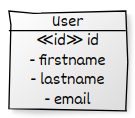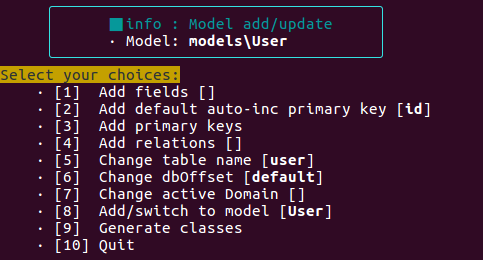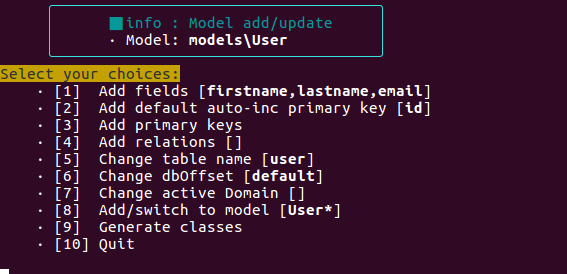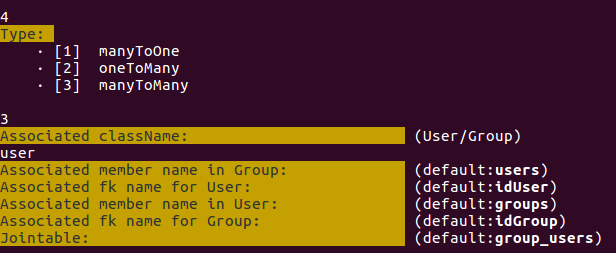Models creation from scratch¶
Note
It is often preferable to design a database conceptually and then generate the models from the existing database.
The creation of models from scratch is only suitable for simple cases, and does not allow to skip a conceptualization phase.
Creating a model¶
Consider the following model representing a user:

We will create it with devtools, in command prompt:
Ubiquity model user

Note
A primary key is automatically added at creation as an auto-increment.
It is possible to change the default name of the primary key when launching the command :
Ubiquity model user -k=uid
Adding fields¶
Select the Add fields menu item:
- Enter the field names separated by a comma:

The added fields:

Generating the class¶

Below is the created model, without the accessors:
1 2 3 4 5 6 7 8 9 10 11 12 13 14 15 16 17 18 19 20 21 22 23 24 25 26 | namespace models;
use Ubiquity\attributes\items\Table;
use Ubiquity\attributes\items\Id;
#[Table('user')]
class User{
#[Id]
#[Column(name: "id",dbType: "int(11)")]
#[Validator(type: "id",constraints: ["autoinc"=>true])]
private $id;
#[Column(name: "firstname",dbType: "varchar(30)")]
#[Validator(type: "length",constraints: ["max"=>30,"notNull"=>false])]
private $firstname;
#[Column(name: "lastname",dbType: "varchar(45)")]
#[Validator(type: "length",constraints: ["max"=>45,"notNull"=>false])]
private $lastname;
#[Column(name: "email",dbType: "varchar(150)")]
#[Validator(type: "email",constraints: ["notNull"=>true])]
#[Validator(type: "length",constraints: ["max"=>150])]
private $email;
}
|
1 2 3 4 5 6 7 8 9 10 11 12 13 14 15 16 17 18 19 20 21 22 23 24 25 26 27 28 29 30 31 32 | namespace models;
/**
* @table("name"=>"user")
*/
class User{
/**
* @id
* @column("id","int(11)")
* @validator("id",["autoinc"=>true])
*/
private $id;
/**
* @column("firstname","varchar(30)")
* @validator("length",["max"=>30,"notNull"=>false])
*/
private $firstname;
/**
* @column("lastname","varchar(45)")
* @validator("length",["max"=>45,"notNull"=>false])
*/
private $lastname;
/**
* @column("firstname","varchar(150)")
* @validator("email",["notNull"=>false])
* @validator("length",["max"=>150])
*/
private $email;
}
|
Modifying existing models¶
Ubiquity model
Without parameters, if some models exist, the model command suggests their loading:

The model to achieve is now the following:

Select the Add/switch to model menu option, and enter group

- Add:
- primary key
idin autoinc - the
namefield - The
manyToManyrelation with theUserclass :
- primary key
